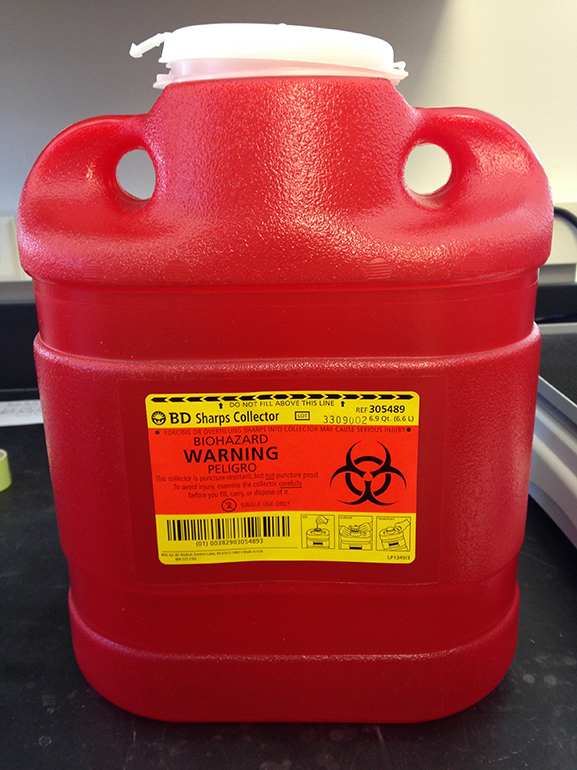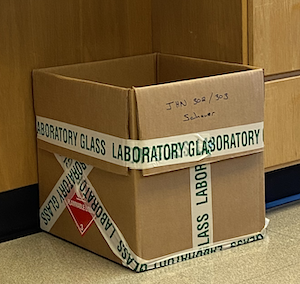Sharps and Glass
Safety
Risk associated with this method include sharp, and potentially contaminated, objects.
While this method is mostly how to dispose of sharps containers, you may have to handle sharp objects in doing so. As such, wear appropriate hand and eye protection to prevent lacerations, infection, and exposure. You may not know where the sharp objects have been.
Contaminated Sharps Disposal

The biohazardous contaminated sharps disposal is mostly used by the bacterial denitrifier method and is for syringe needles or other items that may be biologically contaminated. All syringe needles must be disposed of as if they are contaminated. The active biohazardous container is located on the east wall of 303B in the central bench area behind the muffle furnace. New biohazardous containers are either in the same 303B area in a cabinet or back in the garage (302C).
- Place used contaminated sharps in the rigid, red, plastic biohazard-labeled sharps container.
- When no more than 2/3 full, close the lid and place autoclave tape over the lid and sides. Do not block vent holes.
- Containers must be labeled with the following information:
Principal Investigator name
Johnson Hall (JHN) 303B - Sterilize this entire container using the autoclave located in JHN room 227 and record your use in the logbook.
- If this is your first time using the autoclave, we will provide training.
- Place the biohazard red container into the autoclave tub that is located behind the muffle furnace in 303B. Carry this tub to room 227.
- Select the "Grav 20" program. "Grav 20" is for solids and should take about 45 minutes to complete. "Liquid 60" is for all liquids.
- Sign-in on autoclave log with name, room number, budget number (06-9146), cycle used, and whether or not a test strip is present.
Non-contaminated Sharps Disposal

Laboratory glass and plasticware not contaminated with biohazardous material, chemicals, or radioactive materials must be placed in sturdy cardboard boxes. Any cardboard box may be used, provided it is sturdy and of a size that will not weigh more than 20 pounds when full. The active box is located near the sink of 303B closest to the office. While this box is loosely referred to as the "broken glass" box, any glass, whether it is broken or not, is either recyclable and placed into the JHN hallway recycle containers, or is placed into the "broken glass" box.
- Containers must be labeled with the following information:
Principal Investigator name
Johnson Hall (JHN) 303B - When the box is full, seal it with the "laboratory glass" tape along all edges.
- The "laboratory glass" tape is located in a drawer on the west wall of 303B near the door to the hall under the benchtop centrifuge.
- More tape is available from two sources:
- Chemistry Research Stockroom and is not available on any lab supply source. You can purchase more from the Chemistry Research Stockroom and is part number 7415 with description TAPE, LABORATORY 2 X 55 GLASS.
- From Sticker Mule using this image and as packaging tape.
- If neither printed tape is available, the box can be sealed with other packaging tape as long as the box is well marked as containing "laboratory glass."
- While EH&S suggests placing the sealed box alongside your regular waste container for collection, it is also acceptable to put in on the cart and take it to the loading dock yourself.
No specific EH&S training is required to dispose of items described above, but, you may find additional information about sharps, laboratory glass, and plasticware waste from EH&S
